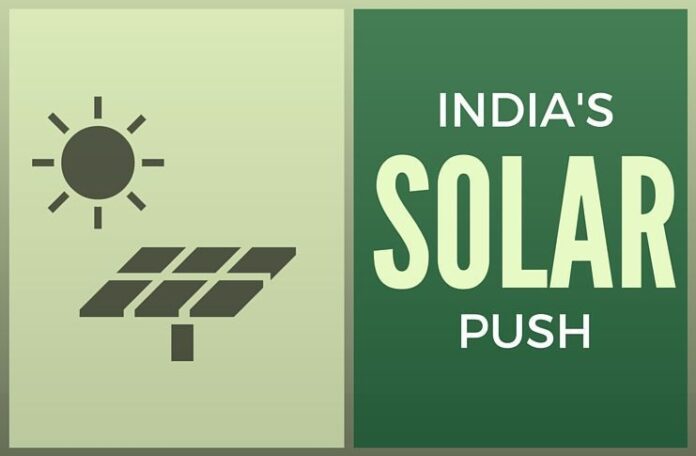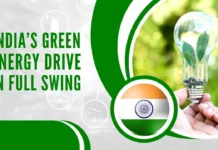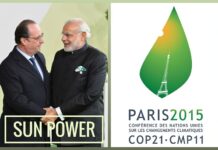
[dropcap color=”#008040″ boxed=”yes” boxed_radius=”8px” class=”” id=””]T[/dropcap]he Prime Minister Narendra Modi has rightly identified Solar Energy as a prime driver for meeting the energy needs of India. He has been making rapid strides globally, pitching for a Solar Alliance to help drive the growth. Such leadership on world stage is a commendable achievement in itself. To prove that India can lead, it must now create the manufacturing infrastructure that will enable it to fulfill not only its needs but also of the Alliance members.
The Jawaharlal Nehru National Solar Mission (JNNSM), a major driving force for the growth of the solar industry, has helped India increase its capacity from a meagre 18 Megawatt (MW) in 2010 to 4 Gigawatt (GW) in 2015. And it shows no signs of abating!
Moreover, the new government announced a revised 100 GW target by 2022, a big jump from an earlier 20 GW. To achieve this, India needs to maintain a cumulative annual growth rate (CAGR) of around 50 percent in annual installations. These targets provide a great opportunity for the Indian solar photovoltaic (PV) industry to evolve as a global leader in manufacturing.
[dropcap color=”#008040″ boxed=”yes” boxed_radius=”8px” class=”” id=””]B[/dropcap]ased on current prices, we estimate that the crystalline Silicon (c-Si) PV technology will contribute around 85-90 GW of the 100 GW target. In 2014, 35 GW of c-Si PV was installed globally, with China’s share being 9 GW.
To manufacture 85 GW of c-Si PV cells, an estimated production of 450,000 tonnes of polysilicon will be required in the next seven years, with the current global production about 300,000 tonnes per year.
If India is to achieve its targets, a huge demand can be foreseen for c-Si PV panels and consequently for polysilicon in the next few years. China, a global leader in polysilicon manufacturing, itself imports polysilicon to meet its demand. This creates a major challenge in diverting a large share of the global production to India, therefore increasing module prices.
PV Manufacturing in India
The Center for Study of Science, Technology and Policy (CSTEP) has analysed the supply chain of PV that consists of production of metallurgical grade Silicon (MG-Si), polysilicon, ingot and wafer, and cell and module assembly. Among these, India possesses only cell and module manufacturing capabilities; other upstream supply chain components are missing. The question is: Given our huge demand from the 100 GW target, should India go in for domestic polysilicon and wafer manufacturing?
Polysilicon price trends
Polysilicon is the basic raw material used in manufacturing c-Si PV cells as well as integrated-circuit chips for the semi-conductor industry. Prior to 2006-07, a majority of the polysilicon production was consumed mostly by the semi-conductor industry. In 2006-07, the economic boom was accompanied by a significant increase in the demand for polysilicon by the solar industry, which resulted in several manufacturing facilities being set up. The recession in late 2008, along with over-production from new factories, caused a slump in the demand for polysilicon and consequently prices plummeted from a peak of $475/kg (Rs.32,500) to $20/kg.
The low prices forced manufacturers into reducing material and energy wastes to stay competitive. Therefore, processes that are more efficient started being developed to make the technology cheaper. This has made the polysilicon industry financially more attractive again in recent years. It is difficult to speculate how these prices will change in future, especially with increase in demand from India. Therefore, there is a case for some domestic manufacturing capability to protect against volatility in prices.
Polysilicon Manufacturing and Challenges
Polysilicon production is an energy-consuming process (60-100 kWh/kg) and needs reliable power sources for continuous operations. High power tariff and unreliable power supply make polysilicon manufacturing challenging in India.
There are three ways to manufacture polysilicon: Siemens process, Fluidized Bed Reactor (FBR) process and Upgraded Metallurgical Grade (UMG) process, with descending order of purity levels – 9N-11N, 6N-9N, and 5N respectively. Solar applications require higher purity levels than 6N pure silicon whereas semiconductor applications need higher purity than 9N. The Siemens process consumes a larger amount of energy as compared to FBR; hence, its cost of production is higher.
Some of the production challenges include handling of materials such as Silane, which is explosive in nature followed by significant heat losses in the reactors.
[dropcap color=”#008040″ boxed=”yes” boxed_radius=”8px” class=”” id=””]T[/dropcap]he current economy of scale suggests that a 24,000 TPA manufacturing plant is optimal and will cost about Rs.5,500 crore. The technology used is the Siemens process, producing about 3-4 GW of c-Si cells annually.
Such a large capital investment in this sector is considered risky by even big investors. Moreover, interest rates in India are relatively higher than in other countries. This makes depreciation and interest rate major cost components (50 percent-70 percent) in polysilicon manufacturing. However, labour costs (skilled and unskilled) in India are lower as compared to other countries and this may reduce the cost of production by 5-10 percent.
The way forward
Given our ambitious solar targets, it is prudent to create at least some domestic polysilicon manufacturing capability. Private industry could form a consortium to venture into domestic manufacturing. The government should support such initiatives and the industry through various incentives (tax holidays, duty exemption and the like) and facilitate the industry by giving special incentives in the modified special incentive package scheme (M-SIPS). The government can also make commitments to investors to provide low-cost finance and low-tariff power similar to China.
An assured market demand with long-term purchase agreements will boost the domestic manufacturing industry, along with the development of a manufacturing cluster – a dedicated R&D facility – for continuous research on new, mature, and disruptive technologies. Continuous updates in enabling policies pertaining to the polysilicon manufacturing industry will prove to be highly beneficial for the sector” growth as well.
(Portions from IANS)
- Subramanian Swamy approaches Supreme Court on Govt’s modification of 2G Scam Judgment to avoid auction of Satellite Spectrum - April 23, 2024
- Defence Minister Rajnath Singh visits Siachen. Reviews military preparedness - April 22, 2024
- Amit Shah’s shares in the Stock Market almost doubled in the past five years - April 21, 2024











Great article! We will be linking to this great post on our website.
Keep up the good writing.